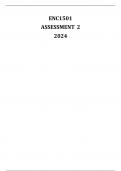ENC1501
ASSESSMENT 2
2024
, Section A
Question 1
1.1 Formal language: Formal language refers to the use of precise, structured, and
standard language in professional or academic discourse. An example is the use of
"shall" instead of "will" in formal writing.
1.2 Didactics of teaching: The didactics of teaching in clude strategies, methods, and
theories used in teaching and learning. For example, using the strategy of group
discussion to enable students to interact with one another to achieve more effective
involvement and understanding on their part.
Question 2
2.1 Listening skills are indeed critical ingredients in communication. Two features of
listening are:
Active Listening: Listening to the speaker keenly, understanding his or her message,
and acting accordingly. Example: A teacher's giving an ear to a question by a pupil
and answering it clearly.
Empathic Listening: It is the process of listening, understanding, and assimilating not
only what the speaker is saying but also his feelings, emotions, and actions. For
example, a counselor hearing the worries of a student and feeling sympathetic to
them.
Section B
Question 3
3.1 Mrs. Chantel can develop listening abilities in grade 1 learners by:
3.1.1 Varying the volume: Showing how volume can change the meaning from one
word (e.g., whispering versus shouting) to demonstrate listening for auditory signals.
3.1.2 Emphasis by stressing words: Intonation used to stress particularly important
words or concepts in lessons, emphasizing meaning by vocal stress.
3.1.3 A regular vocal rhythm: Rhythmic speech patterns used to keep attention and
as an aid to comprehension in young children.
3.1.4 Repetition: Repetition of important information or instructions in order to
reinforce learning and enhance retention for grade 1 students.




